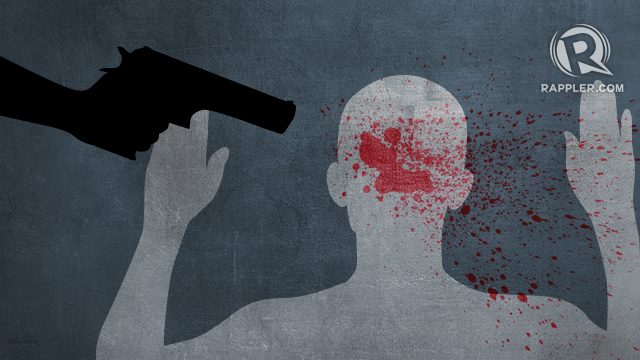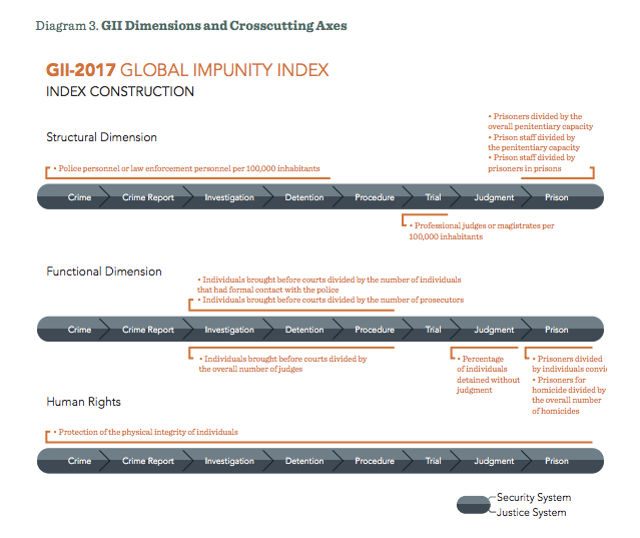SUMMARY
This is AI generated summarization, which may have errors. For context, always refer to the full article.

MANILA, Philippines (UPDATED) – The Philippines is seen as the worst in terms of impunity among 69 countries, according to the latest Global Impunity Index (GII) of the University of the Americas Puebla (UDLAP) and the Center of Studies on Impunity and Justice (CESIJ).
Not to be confused with the impunity index of the Committee to Protect Journalists, which is specific to the journalism profession, the GII tries “to make visible, in quantitative terms, the impunity worldwide and its direct effect in other global issues such as inequality, corruption, and violence.”
The 2017 GII, released in August, cited data gathered from 2012 to 2014, studying 69 countries.
124 other countries that are Member States of the United Nations not part of the index due to a “lack of sufficient information on security and justice to compare them with other countries included in the Index.”
The 2017 GII used the average value of data from 2012 to 2014. If there was only information for one of those 3 years, it would use that. In certain cases, such as its information from Venezuela, the data corresponds to more recent periods – namely, data used is from the period 2015-2016 – but may not sufficiently reflect current events.
It added that the 2015 GII and the 2017 GII are not comparable statistically due to methodological adjustments, the inclusion of additional countries, and the variations in the human rights indicator.
While the GII does use averaged data from 2012 to 2014 in its 2017 edition, the GII recommends it be seen as a “resource to identify impunity levels amongst the countries, analyze variations in each case and remark structural and functional conditions in the countries whose impunity index changes or stays in the same levels for both periods.”
In 2015, information was available to analyze 59 countries. The GII-2017, meanwhile, covered 69 countries. While 16 new countries were added to the Index, the following 6 cases were excluded due to the countries’ failure to report statistical information to the UNODC: Andorra, Bahamas, Cyprus, Guyana, Jamaica, and Malta.
In its description of the Philippines, the GII said the high impunity index is indicative of the country “going through one of its most critical moments, due to the increase of violence related with organized crime and increased terrorist activities from local gangs linked to the Islamic State (ISIS).”
According to the GII, countries with high rates of impunity “can lead to socioeconomic inequality, legal inequality, rule-of-law problems, insufficient economic development, difficulties to attract foreign investment and tourism, as well an increase in human rights violations.”
Structural, functional, and human rights dimensions
The GII assigns a numerical value to the structural, functional, and human rights dimensions surrounding impunity.

The structural dimension “measures the installed capacities of a State to prosecute crimes and deliver justice though procedures respectful of due process.” Meanwhile, the functional dimension “measures the performance of the institutions in charge of prosecuting crimes and delivering justice, regardless of their legal framework.”
The Index added, “the structural dimension refers to the installed capacities as a way to measure the commitment of States to counter impunity, whereas the functional dimension focuses on the actual results of the functioning and institutional organization in each country.”
Meanwhile, the human rights dimension “focuses on the physical integrity of citizens.”
The measure of this is when the government protects physical integrity “by analyzing cases of torture, homicides perpetrated by public officials, political imprisonment, extrajudicial killings, massive homicides, and disappearances.”
Results
| Chart 1. GII and Dimensions 2017 | ||||||||
| Relative position | Region | Country | GII 2017 | Structural | Functional | Human Rights | ||
| Security System | Justice System | Security System | Justice System | |||||
| 1 | Asia | Philippines | 75.60 | 94.06 | 99.07 | 44.64 | 42.64 | 97.99 |
| 2 | Asia | India | 70.94 | 75.70 | 88.96 | 48.22 | 42.86 | 98.95 |
| 3 | Africa | Cameroon | 69.39 | 80.12 | 93.81 | 49.18 | 39.91 | 83.94 |
| 4 | America | Mexico | 69.21 | 68.14 | 94.70 | 47.51 | 35.72 | 100.00 |
| 5 | America | Peru | 69.04 | 78.63 | 97.00 | 46.13 | 39.26 | 84.19 |
| 6 | America | Venezuela | 67.24 | 73.62 | 88.96 | 38.13 | 46.03 | 89.47 |
| 7 | America | Brazil | 66.72 | 73.76 | 88.96 | 38.93 | 34.77 | 97.15 |
| 8 | America | Colombia | 66.57 | 72.80 | 84.26 | 47.24 | 31.55 | 96.98 |
| 9 | America | Nicaragua | 66.34 | 80.27 | 100.00 | 44.22 | 24.49 | 82.75 |
| 10 | Europe | Russian Federation | 65.49 | 56.46 | 60.64 | 87.68 | 25.60 | 97.09 |
While the Philippines is relatively middling in terms of functional security and justice, with scores of 44.64 and 42.64, it has issues when it comes to structural security and justice at 94.07 and 99.07. This points to a lack of manpower, and an average ability to enact and deliver justice.
In terms of the human rights dimension, the Philippines has a 97.99 rating, which points to a lack in the government’s drive to analyze and understand the human rights situation in the country. – Rappler.com
Add a comment
How does this make you feel?
There are no comments yet. Add your comment to start the conversation.